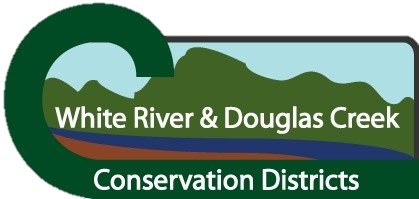|
Rangeland Health is a significant concern to landowners in Rio Blanco County. The County consists of approximately 75% public lands and our economy depends upon the multiple uses of these lands. Well managed lands will provide for all multiple uses and enjoyment of all interested parties. Grazing management of all ungulates is absolutely critical to the health of the range. Healthy rangelands provide habitat and feed for many species. Primary uses of the range in Rio Blanco County include large game species including deer and elk, smaller wildlife species including the Greater Sage Grouse, livestock grazing, and wild/feral horses protected under the 1971 Wild Free-Roaming Horse and Burro Act. |
Range Monitoring is critical to range management. Therefore, the Districts host Rangeland Monitoring workshops and encourage all land managers, private and public, to conduct range monitoring to document and improve range management when necessary. The Districts have partnered with the Colorado Cattlemen's Association and the Colorado State Conservation Board to encourage livestock producers to participate in the Colorado Resource Monitoring Initiative Program. This program provides a third party verified database for the rancher to store their data which can be used for ranch management and public lands decisions regarding livestock grazing.
|
Wild (Feral) Horses
Based on Concerns from local stakeholders, the Districts have been actively engaged in the excess horse issues on a local, state, and national basis for more than ten years.
General Information Links:
- Sage Grouse & Horses:
- Key notes from a paper from The Wildlife Society journal:
- On average, for every 50% increase in horse abundance over the maximum appropriate management levels, the model predicted an annual decline in sage‐grouse abundance by 2.6%.
- When horse populations are at or below the maximum appropriate management levels, the model predicts rates of population change similar to areas without horses – in other words, no predicted impact if horses are kept in check and managed to appropriate management levels – or…in other words… within range carrying capacity given all other uses of vegetation, including wildlife.
- If feral horse populations continue to grow at current rates unabated, the model predicts that sage‐grouse populations will be reduced within horse‐occupied areas by >70.0% by 2034 (15‐year projection), on average compared to 21.2% estimated for control sites.
- Key notes from a paper from The Wildlife Society journal:
- Rangeland Ecological Assessment of Herd and Habitat Condition 2022 data report
- 2018-2021 two-page summary of range monitoring data
- 2018-2021 Range Monitoring data report
- The Appropriate Management Level (AML) within the Piceance East Douglas HMA is 135 - 235. There should be no horses outside of the HMA.
- Based on BLM's March 2021 survey (count), there are between 1,500 and 1,800 horses in Rio Blanco County today. That is after removing 457 from the West Douglas area last year.
- Letter to Director of BLM, Tracey Stone-Manning 2/23/22 from numerous hunting and wildlife conservation organizations and professional societies expressing their support and appreciation for recent commitments by BLM to gather horses across the western range in 2022
- Letter to Acting BLM CO Director, Stephanie Connolly 4/15/22 from numerous conservation organizations supporting the efforts of the CO BLM to manage horses to conserve wildlife habitat and improve ecosystem health
National Information:
Piceance East Douglas Herd Management Area (Local) Information
